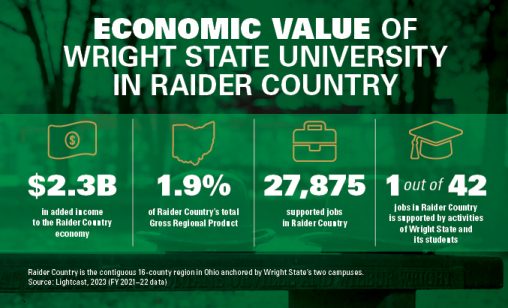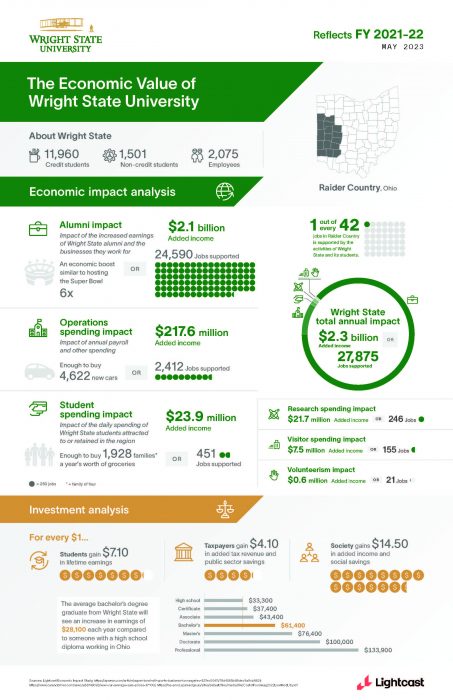Excerpt
 A new economic impact study has found that one of Dayton’s largest universities is adding $2.3 billion to the region’s economy annually. The benefits of the economic impact reach graduates, alumni and taxpayers across the region.
A new economic impact study has found that one of Dayton’s largest universities is adding $2.3 billion to the region’s economy annually. The benefits of the economic impact reach graduates, alumni and taxpayers across the region.
According to an economic impact study by Lightcast, Wright State University adds $2.3 billion to the region’s economy on an annual basis in addition to supporting nearly 28,000 jobs through its operational and research expenditures. With 90% of graduates remaining in Ohio – the highest of any public institution in the state – the university is supplying a steady flow of qualified, trained workers to the Ohio workforce and is improving the quality of life in Ohio.
“The university plays a key role in helping students increase their employability and achieve their individual potential,” the report said. “The university facilitates new research developments and draws visitors and students to the region, generating new dollars and opportunities for Raider Country.”
The study analyzed data from fiscal year 2021-2022, or July 1, 2021 to June 30, 2022.
Wright State’s total impact equals about 1.9% of the gross regional product and is twice as much as the region’s entire utility industry, according to the report. The university supports one out of every 42 jobs across 16 counties in southwest Ohio anchored by the Dayton and Lake campuses, including Greene, Mercer, Allen, Auglaize, Butler, Champaign, Clark, Clinton, Darke, Logan, Miami, Montgomery, Preble, Shelby, Van Wert and Warren counties.
Over the last five years, Wright State’s economic impact has increased by more than 53%. In a previous study analyzing data from fiscal year 2016 to 2017, Lightcast found that Wright State added $1.5 billion annually to the region’s economy and supported more than 20,000 jobs.
Impact of Wright State’s operations
In fiscal year 2021-2022, Wright State employed 2,075 full-time and part-time individuals to support its daily operations – 90% of whom lived in the Dayton region. Total payroll was over $168 million, much of which was spent locally for groceries, mortgages or rent, dining out and other household expenses. Additionally, the university spent more than $77 million on its day-to-day expenses for facilities, supplies and professional services.
During this time, Wright State also spent more than $10 million on payroll to support research activities, which created a net total of nearly $22 million in added income for the regional economy – the equivalent of supporting 246 jobs.
A good investment for students
Wright State served 13,461 students during fiscal year 2021-2022 and offered tuition at one of the lowest rates in the state during this time.
The average Wright State bachelor’s degree graduate will annually earn $28,100 more than someone with a high school diploma or equivalent working in Ohio, according to the study. Over a working lifetime, the benefits of a bachelor’s degree over a high school diploma will amount to $1.2 million in higher earnings per graduate.
While attending Wright State, the study found that relocated and retained students spent money on groceries, accommodations, transportation and other household needs, generating nearly $24 million in added income to the region.
Both students and employees are encouraged to volunteer with local businesses and organizations to help them grow, increase their output and impact the economy. The work of these volunteers is equivalent to $288,300 in earnings and generated $561,100 in added income to the region; the study found that this was equivalent to supporting 21 jobs.

Alumni spread Wright State’s local impact
The study found that Wright State’s greatest economic impact on the region has come from entrepreneurship, experience and innovation from the 67,000 alumni that remain in the region, amounting to roughly 56% of the university’s graduates. During fiscal year 2021-2022, alumni generated over $2 billion in added income for the economy – the equivalent of supporting 24,590 jobs.
A good investment for taxpayers
Students and graduates aren’t the only people benefitting from Wright State University. The report found that Wright State generates more in tax revenue than it receives – primarily from taxes that the state and local government collect from the added revenue created in Ohio.
Taxpayer benefits consist of the savings generated by students’ improved lifestyles and a corresponding reduction in government expenditures on health care, the justice system, unemployment benefits and other social services. These benefits will generate a present value of over $77 million in savings to state and local taxpayers, according to the study.
Social benefits of Wright State benefits are equivalent to a present value of over $5 billion, including $3.3 billion in added student income, $1.3 billion in added business income, over $233 million in added income from university activities and over $256 million in social savings state-wide.
Ohioans invested a present value total of $350.8 million in Wright State in fiscal year 2021–2022. For every dollar invested in Wright State, Ohioans will receive a cumulative value of $14.50 in benefits.
The full report from Lightcast can be read here.
Wright State is one of the largest universities in the Dayton region with nearly 11,000 students and 1,800 employees.
Lightcast is a data analysis company specializing in economic impact studies and labor market data in relation to educational institutions, workforce planners and regional developers in the United States and internationally.
View the original post at bizjounrals.com

 Milling around
Milling around  Wright State recognizes Nursing Professor Kim Ringo for advancing international student success
Wright State recognizes Nursing Professor Kim Ringo for advancing international student success  Wright State honors graduating students for distinguished doctoral dissertations
Wright State honors graduating students for distinguished doctoral dissertations  Top 10 Newsroom videos of 2025
Top 10 Newsroom videos of 2025  Museum-quality replica of historic Hawthorn Hill donated to Wright State
Museum-quality replica of historic Hawthorn Hill donated to Wright State 